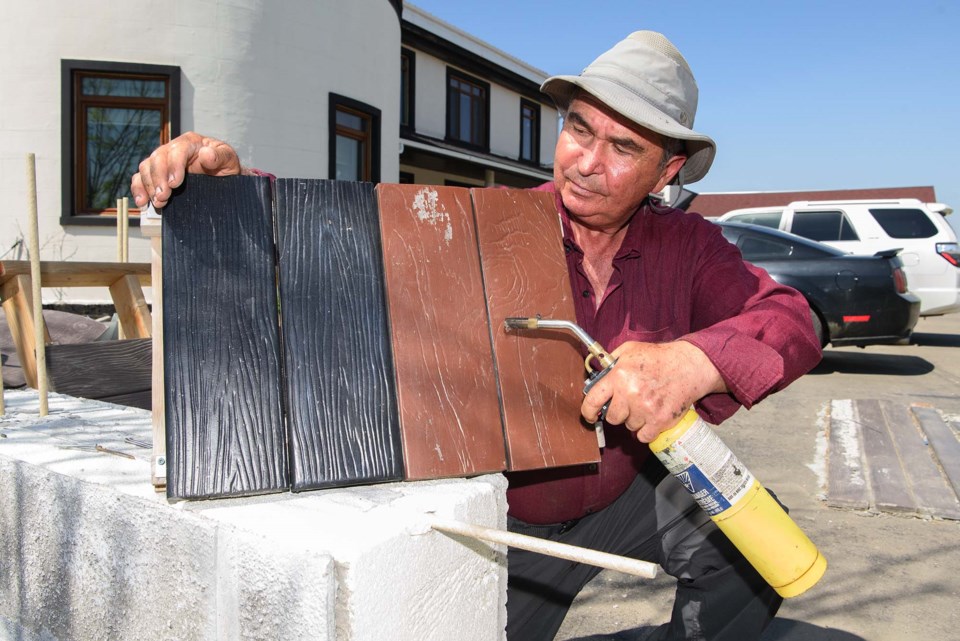This Green House
The Gazette is taking a close look at how to improve your home to guard against climate change. Got a question on climate mitigation? Send it to [email protected] to be answered in a future column.
With wildfires blazing throughout Alberta this spring, including some right on St. Albert’s doorstep, some homeowners might worry that their home could be at risk.
Mehmet Yigit isn’t. The founder of MYBloc Construction, his ultra-efficient home just north of the Hwy. 37/Hwy. 2 intersection in Sturgeon County (which was featured on the 2018 Eco-Solar Home Tour) is made of fireproof materials, many of which he invented himself.
“We have fireproof walls, fireproof doors, and fireproof roof,” he said, and he’s working on fireproof window frames and deck planks next.
“That’s why I don’t worry about any fires.”
Global heating means hotter, drier summers and greater risk of wildfires like the ones torching Alberta right now. But while homeowners could try and make their homes fireproof like Yigit’s, they should probably start by making those homes FireSmart.
Get FireSmart
FireSmart is a popular program in Alberta that shows residents how to reduce wildfire risk by addressing fire hazards around their home. A 2017 study on the 2016 Fort McMurray wildfire found that 81 per cent of the homes that survived that fire had adhered strongly to FireSmart principals.
FireSmart is all about keeping fuel, and thereby fire, away from your home, explained Sturgeon County fire chief Pat Mahoney.
“If there’s more fire load, there’s more stuff to burn, then it’s going to create a bigger, hotter fire which makes it more difficult for us.”
FireSmart advises residents to keep dry branches, leaves, and furniture at least 1.5 m from their homes, and to keep firewood at least 10 m away. Roofs and gutters should be kept free of debris, while external vents on your roof (except for the dryer vent) should have thee-millimetre screens over them to keep hot embers from blowing into your home. In the yard, favour leafy deciduous trees over flammable evergreens, and keep them at least three meters apart. Mahoney advises against using bark mulch in gardens, as it’s very flammable.
In St. Albert, fire prevention means managing deadwood in forests, keeping firewood and fire pits away from trees and walls, and making sure fire pits have stone or concrete pads under them, said city fire prevention officer Mike Bos. A garden hose with a nozzle can also help you stamp out any fires that do start.
“If you’re a smoker, make sure you have a non-combustible ashtray,” Bos added — many St. Albert fires are caused by cigarette butts shoved into planters, causing the flammable peat moss in them to flare up hours later.
Firesmartcanada.ca has plenty of resources available on how to guard your home against wildfires.
Get fireproof
Once you’ve made your yard FireSmart, you can make your home more fireproof.
Most modern asphalt roof shingles will last 15 to 20 minutes against hot embers, said Allen Shaw of Shaw Roof Consulting, who does roof inspections throughout the Edmonton region. While you could switch to fireproof metal or ceramic shingles instead, Shaw said 15-20 minutes is usually enough time for the fire department to arrive, adding that in 35 years he had yet to see a home burn down due to embers landing on asphalt shingles.
Cedar shingles are a different story.
“Wood is flammable,” Shaw said, and if your home is near any kind of tree stand, those trees can rain hot embers onto your wood roof and set it ablaze.
Vinyl siding offers little fire protection as it can melt or burn, Shaw said. He recommends replacing it with metal, brick, or stucco. Interestingly enough, that 2017 Fort McMurray study found that vinyl siding was not a significant fire risk — about 73 per cent of surviving homes had it — provided the house it was on followed FireSmart guidelines. Homes with vinyl over stucco also proved highly resistant to ignition from radiant heat.
If wildfire comes to your door, Mahoney and Shaw said to have a “bug-out” bag handy containing your important documents and medication and enough food, water, and clothes to last 72 hours. Alberta.ca/build-an-emergency-kit.aspx has advice on what to put in such a bag.
Shaw said Fort McMurray shows how a properly prepared home can survive a wildfire. A fireproofed home should also last longer, and could qualify you for cheaper insurance rates.
Yigit’s home has a third, indirect form of wildfire protection: energy efficiency. His 6,000 square-foot home is so well insulated that it’s 17 C inside when it’s 32 C outside, and uses roughly the same amount of natural gas as an Edmonton home one-third its size. That means less heat-trapping pollution added to the air, less global heating, and less fire risk.
FireSmart and fireproofing can protect your home against a fire. Energy efficiency can help make that fire less likely to happen.



